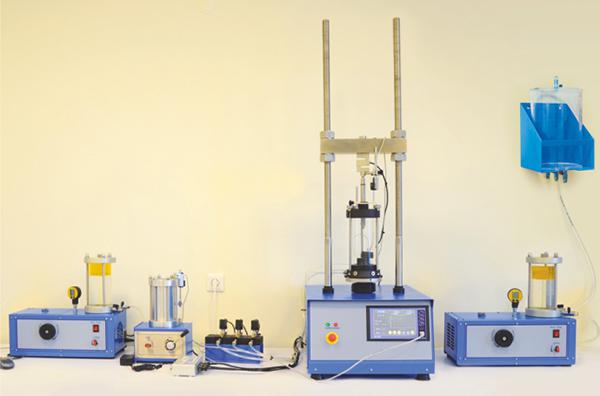
ZI 3095
This is an Automatic Triaxial Testing Machine used to perform consolidated undrained and consolidated drained triaxial test.
Consolidated Undrained (CU) Test & Consolidated Drained (CD) Test
Peak effective strength parameters (c' and f') may be determined either from the results of consolidated undrained (CU) triaxial compression tests with pore pressure measurement, or from consolidated drained (CD) triaxial compression tests. The consolidated undrained/ drained triaxial compression tests are normally performed in several stages, involving the successive saturation, consolidation and shearing of each of three specimens.
Saturation is carried out in order to ensure that the pore fluid in the specimen does not contain free air. Saturation is normally carried out by leaving the specimens to swell against an elevated back pressure. Back pressure (which is simply an imposed pore pressure) is applied through a volume change gauge to the top of the specimen, while a cell pressure of slightly higher value is also applied. Both cell pressure and back pressure are normally increased in increments, allowing time for equalization at each stage. The degree of saturation can be expressed in terms of Skempton's pore pressure parameter.
Consolidated Undrained (CU) Test:
Once consolidation is complete, the specimen is to be isolated from the back pressure and the rate of vertical movement of the compression machine platen set according to result of consolidation.. During the shear stage the vertical stress is increased by the loading ram, and measurements are made at regular intervals of deformation, ram load and pore pressure. These are converted to graphs of principal stress difference (s1- s3) and pore pressure as a function of strain, and failure is normally taken as the point of maximum principal stress difference. The effective stress Mohr circles are plotted for the failure conditions of the three specimens which has been subjected to different consolidation level, and the gradient and intercept of a straight line drawn tangential to these circles defines the effective strength parameters c' and f'.
Consolidated Drained (CD) Test:
The consolidated drained triaxial compression test, with volume change measurement during shear is carried out in a similar sequence to the consolidated undrained test, but during shear the back pressure remains connected to the specimen which is loaded sufficiently slowly to avoid the development of excess pore pressures. The shear stage of a drained triaxial test can be expected to take between 7 and 15 times longer than that of an undrained test with pore pressure measurement. Once shearing is complete, the results are presented as graphs of principal stress difference and volume change as a function of strain, and the failure Mohr circles are plotted to give the drained failure envelope defined by the parameters cd' and fd' .Triaxial CD-CU-UU equipment is computer controlled, test values can be transferred to computer and data processing can be made with Triaxial software on Windows operating system. All data can be used on Excel programs. The load data and axial displacement data are transfered and recorded through the software. Three pressure data (cell pressure, back pressure and pore pressure) from triaxial cell and volume change data transfered and recorded through the unilogger to the software.
Multiplex Universal Electromechanic Test Machine
The Multiplex Universal Electromechanic Test Machine is a Servo Controlled Multiplex Machine supplied complete with 50 kN Load Cell, 25 mm Linear Potentiometric Transducer and Data Acquisition and Control Unit. 5 kN Loadcell should be ordered separately for Triaxial Tests.
The Frame capacity is 50 kN. This versatile digital loading frame features a microprocessor controlled drive system with an advanced servo motor enabling the operator to easily set any test speed via the membrane keyboard. The keyboard comprises adjustment buttons such as “start”, “increase”, “automatic”, “manual”, “down”, “up”. The testing speed can be set between 0,00001 mm/min to 51mm/min. The test automatically stops when load and displacement is reached to 99% value of the set measuring range. See page 243 to 245 for details.
Load and displacement values are collected by Software and transferred to PC for further processing with the UU and CU-CD Software.
